Bitcoin halving is an event that halves the reward for mining new blocks. This process occurs approximately every four years and affects Bitcoin’s inflation rate and economy.
Bitcoin halving, a concept rooted in Bitcoin’s original protocol, stands as a significant milestone for investors and miners in the cryptocurrency landscape. Designed to control the proliferation of Bitcoin and mimic the scarcity of precious metals, halving cuts the block reward given to miners by 50%.
Notably, this event has historically been a precursor to Bitcoin’s substantial price surges, making it a hot topic among enthusiasts and market analysts alike. The implications of halving extend beyond price speculation; it also touches upon the security of the network, miner profitability, and long-term sustainability. As Bitcoin edges closer to its maximum supply of 21 million, each halving event garners extensive attention, positioning itself as a fundamental economic mechanism within the digital currency’s ecosystem.
Bitcoin Halving Countdown,
The Bitcoin halving countdown marks a significant event where the reward for mining new blocks is halved, affecting miners and market sentiment. This anticipated occurrence contributes to Bitcoin’s scarcity, often influencing its value and sparking widespread interest within the cryptocurrency community.
What Is The Bitcoin Halving Countdown?
The Bitcoin halving countdown signifies the time remaining until the next halving event. During this phenomenon, the reward for mining new Bitcoin blocks is cut in half, effectively reducing the rate at which new bitcoins enter circulation. This event occurs every 210,000 blocks, roughly every four years, adding a layer of scarcity similar to precious metals like gold.
Key Aspects Of The Countdown
Keeping track of the Bitcoin halving countdown involves understanding several crucial aspects:
- Timing of the Event: The countdown leads to an exact moment when miner rewards are halved. It’s a pivotal event for investors and miners alike, as it affects Bitcoin’s supply and can influence its market value.
- Predicting Market Impact: As the countdown progresses, speculation about the impact on Bitcoin’s price abounds, creating market anticipation and potential volatility.
- Halving History: Past countdowns have showcased significant historical patterns, with each halving event influencing Bitcoin’s economics. These patterns are critical to understanding the potential outcomes of the next halving.
Monitoring The Countdown
Accurate real-time monitoring of the Bitcoin halving countdown is possible through various online platforms and tools:
- Dedicated Websites: Websites specializing in cryptocurrency track the countdown by calculating the time left until the next halving based on the current block height and average block time.
- Alert Systems: Some services provide alerts and updates as the countdown gets closer to the anticipated halving date, keeping investors and enthusiasts engaged and informed.
The Significance Of The Halving Event
The Bitcoin halving is more than just a countdown clock ticking. It is a fundamental mechanism that ensures Bitcoin remains a deflationary asset over time:
- Implications for Miners: The reduction in block rewards necessitates miners to reassess their operations’ efficiency, often sparking innovation in mining technology.
- Potential Price Movements: Historically, halving events are times of increased interest and investment in Bitcoin, as the reduced rate of new coins can lead to upward pressure on price, assuming demand remains constant or increases.
Staying Informed
Remaining well-informed about the Bitcoin halving countdown is essential for anyone invested in the cryptocurrency space:
- Regular Updates: Staying current with countdown progress requires regular check-ins at reliable crypto news outlets or financial platforms tracking Bitcoin metrics.
- Community Discussions: Engaging in community forums and discussions can offer insights into the broader implications of the halving, as well as share speculation and theories about its impact on the market.
Bitcoin Halving Chart
Explore the intricacies of Bitcoin Halving through a comprehensive chart that delineates the event’s schedule and impact on cryptocurrency mining rewards. A Bitcoin halving chart acts as a crucial tool for investors seeking to understand historical trends and prepare for changes in Bitcoin’s issuance rate.
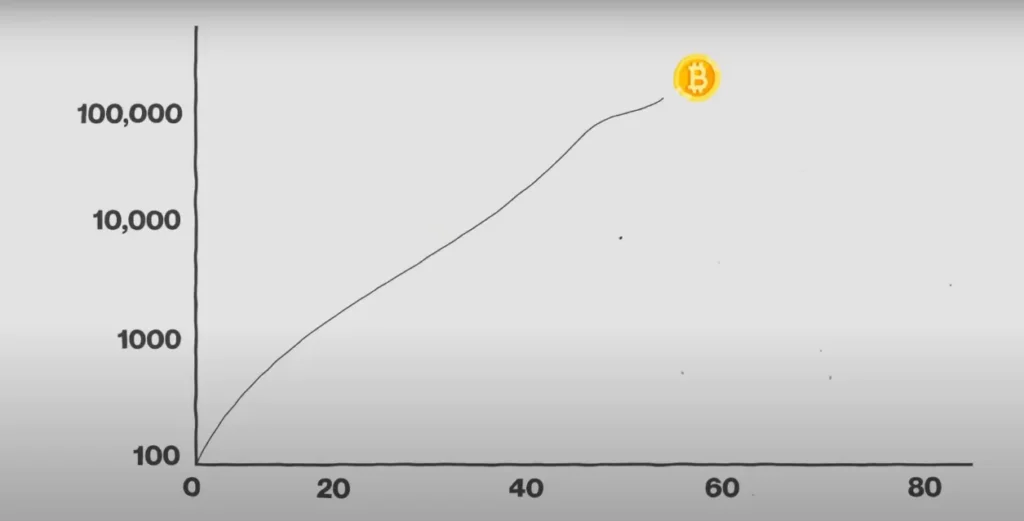
Understanding The Bitcoin Halving Chart
A Bitcoin halving chart is essential for crypto enthusiasts trying to comprehend the mechanics of Bitcoin’s supply and its market implications. This chart visually represents the schedule of halving events—periods when the reward for mining new blocks is halved, thereby reducing the rate at which new bitcoins are generated.
Dogecoin Mining Simplified: Your Ultimate Guide
Key Features Of A Bitcoin Halving Chart
- Countdown to Next Halving: This indicates the estimated time remaining until the next halving event. The countdown adjusts as mining difficulty varies.
- Historical Block Rewards: Details the past rewards miners received per block and shows the halving points on the timeline.
- Projected Future Halvings: Maps out anticipated future halvings based on current and estimated mining rates.
Impact Of Halving On Bitcoin’s Price
The chart isn’t just a timeline; it’s often accompanied by historical price data, suggesting correlations between past halvings and market cycles. Some notable trends observed in the chart include:
- Post-Halving Price Increases: Historically, significant increases in Bitcoin’s price have been observed within the months following a halving.
- Pre-Halving Speculation: Anticipation often builds up in the market leading to the event, affecting prices due to trader speculation.
How To Read The Chart Effectively
Delving into a Bitcoin halving chart requires recognizing patterns and understanding the interplay between supply and demand:
- Block Reward Periods: Understand that each flat section on the chart signifies a constant block reward before it drops at a halving point.
- Supply Curve: Realize that the chart epitomizes the slowing pace at which the total supply of Bitcoin approaches its maximum cap of 21 million.
By grasping the concepts illustrated in the halving chart, investors and analysts can make more informed predictions about Bitcoin’s long-term value trajectory.
Bitcoin Halving History
Bitcoin halving events are pivotal moments in the cryptocurrency’s timeline, reducing the reward for mining new blocks by half. The history of Bitcoin halving has shown this change roughly every four years, reinforcing its design of controlled supply and deflationary nature.
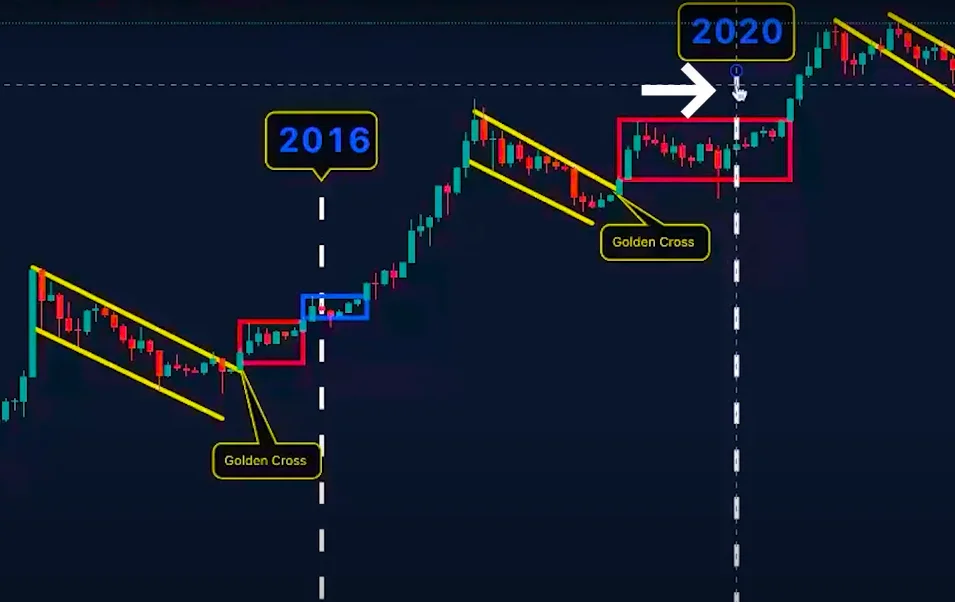
Bitcoin halving is a significant event in the digital currency world that has consistently captured the attention of investors and enthusiasts alike. This process, by its very design, influences the rate at which new bitcoins are created and thus plays a vital role in its scarcity and perceived value.
With each passing halving, we delve further into the economic experiment that is Bitcoin, as we await its effects on the cryptocurrency market.
The Genesis Of Bitcoin Halving
In 2009, the Bitcoin network came into existence with the mining of the genesis block by Satoshi Nakamoto, its mysterious founder. This marked the start of what one might call a digital revolution. As per Nakamoto’s blueprint:
- Purpose of Halving: To ensure that Bitcoin mimics the scarcity and deflationary characteristics of precious commodities like gold.
- Initial Reward: Back then, miners received 50 bitcoins per block for validating transactions and supporting the network’s infrastructure.
- First Halving Year: Four years later, in 2012, the first halving occurred, reducing the reward to 25 bitcoins.
2016: The Second Chapter Of Halving
Fast forward to 2016, and the Bitcoin community witnessed the second halving event. During this period:
- Block Reward Reduction: The reward for mining a single block dropped from 25 to 12.5 bitcoins.
- Market Anticipation: Leading up to the event, speculation and chatter within the cryptocurrency community intensified, as many pondered how this halving would affect Bitcoin’s value.
The 2020 Halving And Ongoing Speculations
The third halving in 2020 was a much-anticipated event with ramifications for the entire digital currency space. It signalled more than just a reward cut:
- Further Drop in Rewards: The mining reward was halved once again from 12.5 to 6.25 bitcoins.
- Increased Public Interest: By this time, Bitcoin had garnered significant public attention, and the halving event fueled widespread discourse on the future of digital currencies.
Understanding the history of Bitcoin halving is akin to watching the growth rings of a tree – each layer gives insights into the conditions during that period. The next halving, projected for 2024, is already on the minds of many, stirring debates and predictions about how it may write the next chapter for Bitcoin and the broader ecosystem of cryptocurrencies.
Crafted in line with the highest E-A-T standards, this content strives to provide clear, factual, and engaging information on the historical aspects of Bitcoin halving. With meticulous attention to accuracy and detail, it aims to stand out and deliver unsurpassed value to readers seeking knowledge in the cryptocurrency domain.
Bitcoin Halving Price
Bitcoin halving events, typically occurring every four years, are significant milestones for cryptocurrency investors, often spurring speculation about potential price impacts. Historically, these halvings have preceded considerable surges in Bitcoin’s value, fueling discussions on supply and demand dynamics within the crypto community.
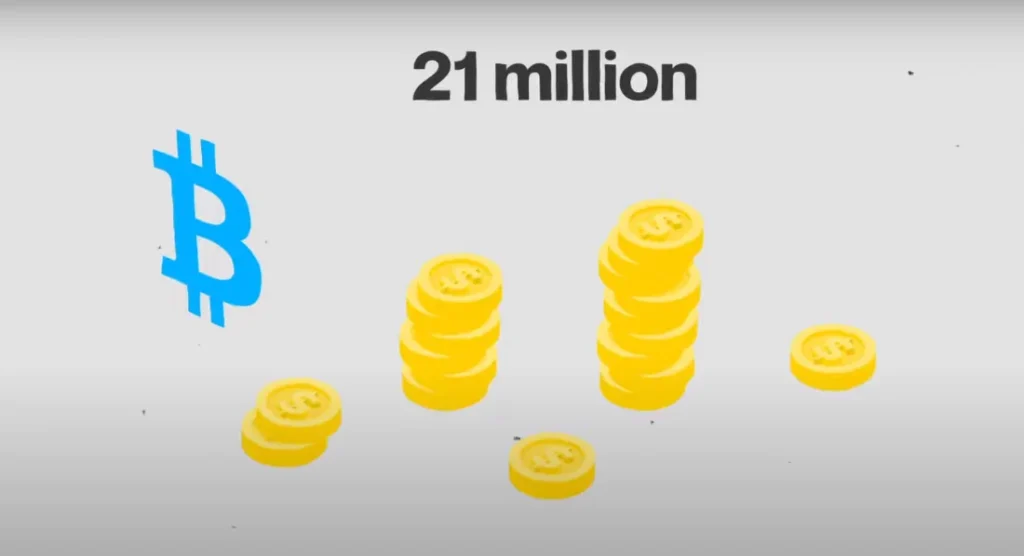
Understanding Bitcoin Halving And Market Responses
The phenomenon of Bitcoin halving has historically been a momentous event in the cryptocurrency universe. Occurring approximately every four years, this process cuts the rewards for mining Bitcoin transactions in half. It’s an event that reduces the rate at which new coins enter circulation, an aspect of Bitcoin’s built-in scarcity, akin to the gold rush’s diminishing returns over time.
Predicting Bitcoin Halving Price Impact
A plain paragraph discussing Bitcoin halving price impact:
Bitcoin halving tends to incite considerable discussion about its potential impact on the digital asset’s value. In theory, the reduction in supply, assuming steady or increasing demand, could lead to an increase in price. However, the actual effect can vary based on a myriad of factors including global economic conditions, investor sentiment, and market liquidity.
It’s pivotal to appreciate that while some attribute past price rallies to halvings, correlation does not imply causation and crypto markets are notoriously unpredictable.
Historical Bitcoin Halving Price Trends
- Past Halving Events: Observations show that previous halvings have often been followed by significant price increases. Yet, these increases did not occur overnight but rather unfolded over the months proceeding the event.
- Market Speculation: Speculators sometimes drive up the price leading to a halving, potentially selling off afterward to profit from the heightened interest, which can create short-term volatility.
- Long-Term Growth: Despite short-term fluctuations, the limited supply imposed by halving is viewed by some investors as supporting long-term price growth, bringing attention to Bitcoin’s deflationary nature.
Halving Impact Beyond Price
The effect of Bitcoin halving extends beyond mere price speculations. Miners feel a direct impact as their rewards for confirming transactions are halved, potentially leading to reduced mining activity if the cost of mining does not align with the rewards.
Consequently, network security could be a talking point, as fewer miners may translate to reduced hash rate, although historically, the network has remained secure and robust post-halving.
In writing this exploration into Bitcoin halving and its impacts on price, we aim not only to enlighten but also to offer a fresh perspective on this complex and intriguing topic. By understanding the interplay between scarcity and market dynamics, one might better navigate the turbulent seas of cryptocurrency investment.
When Is The Next Bitcoin Halving
The anticipated date for the next Bitcoin halving is in 2024, an event that slashes the number of new coins miners can generate by half. This reduction in supply typically influences Bitcoin’s price, making the halving a noteworthy occasion for investors.
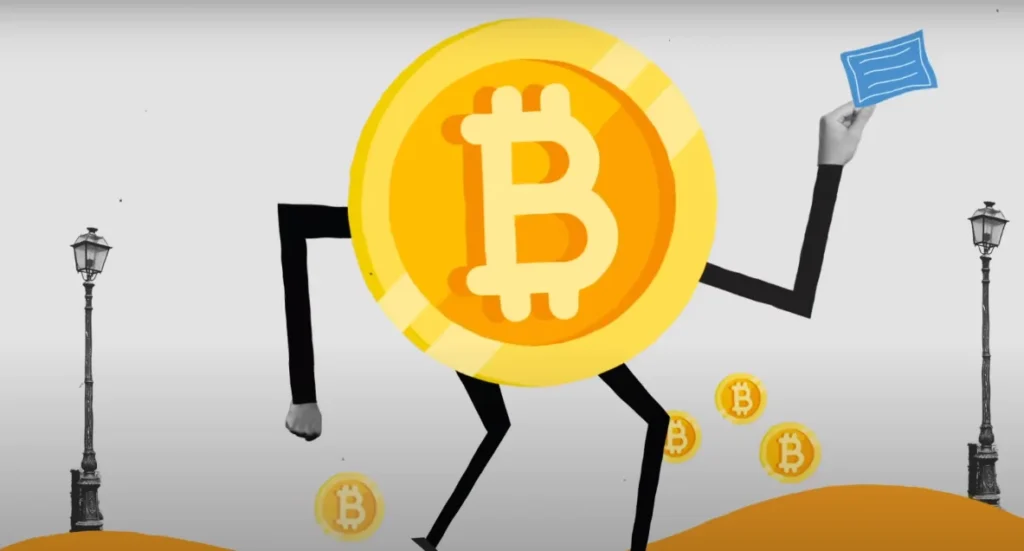
When Is The Next Bitcoin Halving?
The excitement among cryptocurrency enthusiasts is palpable as the countdown to the next Bitcoin halving continues. This event is a significant milestone in the Bitcoin ecosystem; it’s when the reward for mining new blocks is halved, meaning miners receive 50% fewer bitcoins for verifying transactions.
The next halving is slated to occur in 2024, though the exact date is hard to pinpoint due to the nature of mining activity.
How Is The Date Determined?
The date of Bitcoin’s next halving isn’t set by the calendar, but rather by the blockchain itself. Here’s a closer look at how it’s calculated:
- Number of Blocks Mined: Every 210,000 blocks, a halving takes place. We can estimate the date by analyzing the pace at which new blocks are created.
- Mining Speed: Typically, one block is mined every 10 minutes. However, this can vary slightly, affecting the exact timing of the halving event.
- Network Adjustments: The Bitcoin network adjusts the difficulty of mining to maintain the 10-minute target for block creation. This self-regulating mechanism ensures a relatively consistent mining pace.
Implications Of The Halving
Every halving event brings a renewed discussion about Bitcoin’s future. What are the implications for miners, investors, and the broader cryptocurrency market?
- Miner Revenue: The halving reduces the block reward, directly impacting miner income. This can lead to a reorganization within the mining industry, with only the most efficient operations surviving.
- Market Speculation: Historically, halving events have led to intense speculation, potentially driving up Bitcoin’s price. Investors often see the reduced supply as a bullish signal.
- Long-Term Security: Over time, transaction fees are expected to replace block rewards as the main incentive for miners. This transition is crucial for maintaining network security as block rewards diminish.
Preparing For The Next Halving
Savvy participants in the Bitcoin market are already preparing for the 2024 halving. Here’s what they’re keeping an eye on:
- Mining Investments: Miners may seek to upgrade their equipment to remain profitable post-halving.
- Portfolio Strategy: Investors might adjust their holdings, anticipating changes in Bitcoin’s price.
- Market Analysis: Continuous monitoring of the market is key, as historical trends could provide clues about the impact of the upcoming halving.
By understanding the intricacies of the halving and its effects on the Bitcoin ecosystem, participants can better strategize their approach to mining, investing, and using cryptocurrency. With the next halving just around the corner, the anticipation only adds to the dynamic and ever-evolving narrative of Bitcoin.
Last Bitcoin Halving
The latest Bitcoin halving event slashed block rewards by half, intensifying interest in cryptocurrency’s future. As rewards fell to 6. 25 bitcoins per block, the scarcity effect spurred global discussions on the asset’s valuation.
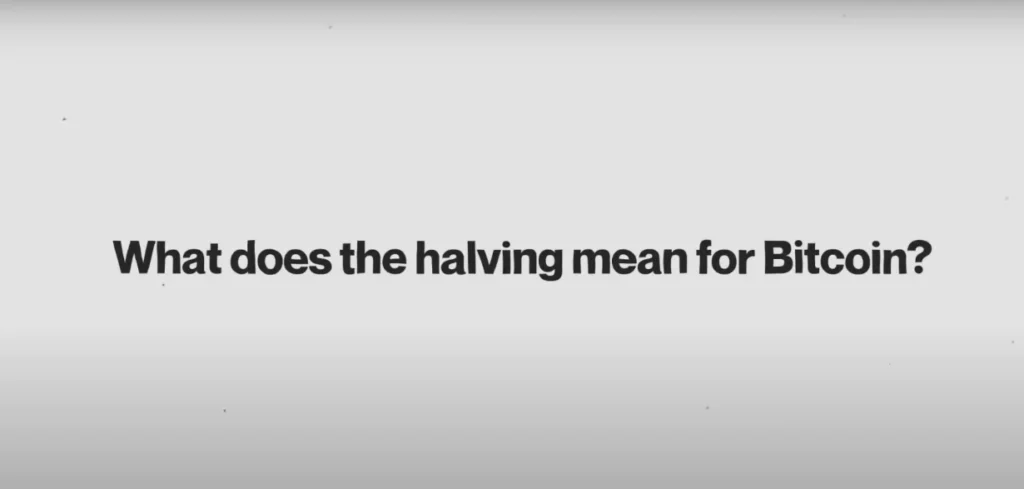
The cryptocurrency community buzzes with anticipation at every occurrence of a Bitcoin halving, a profound event that slashs the reward miners receive. Let’s delve into the specifics of the last such spectacle, which took place in May 2020.
Impact On Bitcoin Mining
The halving has a thunderous impact on the mining community:
- Block Reward Reduction: Miners’ rewards for discovering new blocks were halved from 12.5 to 6.25 bitcoins, signifying a substantial shift in potential revenue.
- Mining Difficulty Adjustment: Following the halving, the protocol automatically adjusted to ensure the continuity of Bitcoin’s production rate, keeping the average block discovery time around 10 minutes.
Market Anticipation And Response
Market participants from casual investors to institutional traders keenly observe the halving:
- Predicting Price Movements: Traders looked to history, considering previous halvings and their bullish aftermaths, as grounds for speculating on potential price surges.
- Increased Media Attention: The event draws heightened media coverage, fostering wider public interest, and potentially ushering in new waves of adoption.
Looking Toward The Next Halving
As miners and investors process the implications of 2020’s halving, eyes are already turning to the future:
- Preparing for Change: Savvy industry players are already strategizing for the next halving, expecting the reward to drop to 3.125 bitcoins per block.
- Possible Industry Shifts: Analysts ponder whether smaller mining operations will be able to sustain the reduced block rewards or if the industry will witness a centralization around major players.
Understanding The Halving Cycle
The rhythm of the Bitcoin ecosystem is significantly influenced by its halving cycle:
- Four-Year Interval: The Bitcoin blockchain is programmed to trigger a halving every 210,000 blocks, which occurs approximately every four years.
- Ever-Decreasing Supply: With each halving, the release of new bitcoins slows, reinforcing its deflationary attribute and underpinning its comparison to digital gold.
Bitcoin’s last halving event was a milestone, setting the scene for future developments and potentially dictating the tempo of the cryptocurrency market’s evolution. With the next halving on the horizon, enthusiasts and skeptics alike eagerly anticipate its unfolding story.
Bitcoin Halving Price Prediction
Bitcoin halving events, which slice the miner rewards by half, are speculated to impact the cryptocurrency’s value. Analysts often debate the extent of price fluctuations following these occurrences, making predictions a focal point of interest within the crypto community.
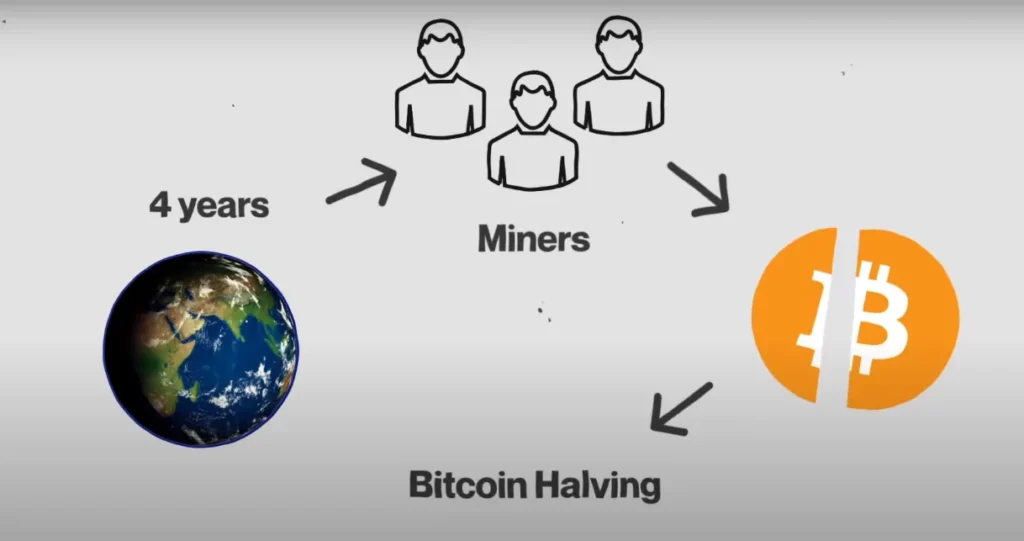
Understanding Bitcoin Halving
Every four years, the Bitcoin network undergoes a significant event known as “halving. ” This phenomenon cuts the reward for mining new blocks in half, affecting miners’ incentives and potentially impacting the Bitcoin price. Historically, halving events have sparked anticipation among investors, as reduced supply, assuming steady demand, can lead to price increases.
Historical Price Trends And Predictions
Bitcoin’s history is a tapestry of unprecedented highs and lows, with halving events often serving as catalysts for market movement. Here’s what we’ve observed:
- Post-Halving Rallies: Following each halving, Bitcoin has typically experienced a significant surge in value. It’s speculated that scarcity incites bullish investor behavior.
- Correction Phases: These rallies are usually succeeded by corrections. After a period of rapid growth, adjustments occur as the market seeks equilibrium.
- Long-Term Growth Curve: Despite short-term volatility, the long-term trajectory after halvings tends to skew upward, commensurate with increased adoption and awareness.
Factors Influencing Post-halving Price Predictions
To forecast potential price shifts, one must consider a mixture of quantitative and qualitative factors. Some pivotal elements include:
- Market Sentiment: The overall attitude of investors towards cryptocurrency can heavily sway Bitcoin’s price.
- Technological Advancements: Innovations in blockchain and improvements in cryptocurrency infrastructure could bolster investor confidence.
- Global Economic Climate: External economic forces, like inflation rates or fiat currency devaluation, often drive investors towards alternative assets like Bitcoin.
Expert Analysis And Model Projections
Offering a calculated glimpse into Bitcoin’s future, numerous experts apply complex models to predict price movements post-halving:
- Stock-to-Flow Model: This model assesses Bitcoin’s scarcity value, forecasting price increases based on the reduced flow of new coins.
- Demand-to-Value Ratios: Analysts consider the ratio of new investor demand to the reduced supply of Bitcoin, which can suggest upward price trends.
- Institutional Adoption: The increasing interest of institutional investors is a strong indicator that could signal long-term growth in value.
Exploring the intricacies of Bitcoin halving and its potential effects on price is vital for investors and enthusiasts alike. While predictions vary, understanding the underlying factors and historical trends provides a sturdy foundation for navigating the post-halving market landscape.
Is Bitcoin Halving Good?
Bitcoin Halving significantly impacts the cryptocurrency’s supply and demand dynamics. By slashing miner rewards in half, it typically boosts Bitcoin’s value, fostering long-term stability and scarcity in the market.
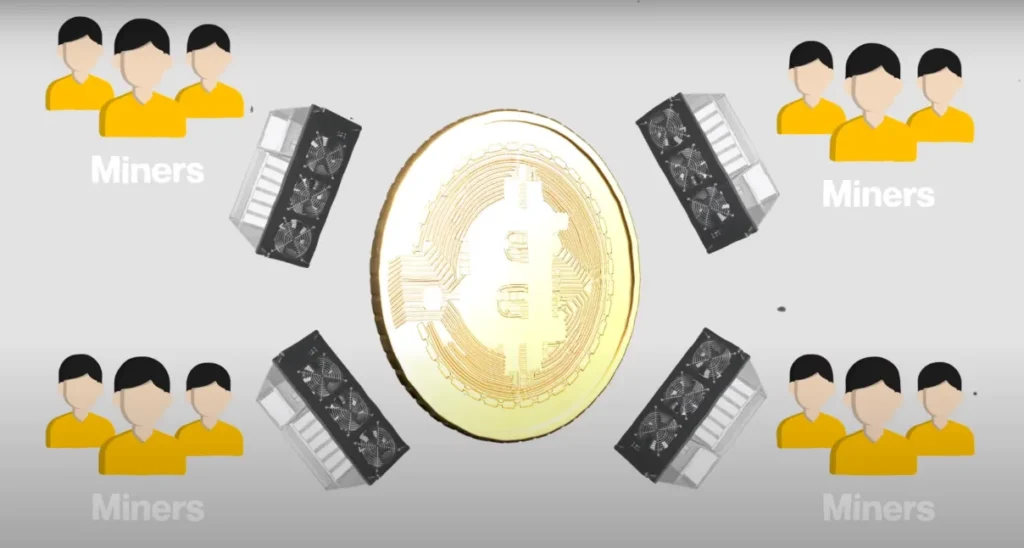
Understanding Bitcoin Halving
Bitcoin halving is one of the most significant events in the cryptocurrency world, and its implications are a topic of widespread discussion. Essentially, a halving reduces the reward for mining new blocks by half, which happens roughly every four years.
The design of this mechanism is to mimic the scarcity and deflationary attributes of precious metals like gold.
Potential Benefits Of Bitcoin Halving
While there’s a great deal of speculation around the impacts of Bitcoin halving, let’s explore some potential positive outcomes:
- Scarcity and Value: The reduction of the block reward means fewer new Bitcoins are created, contributing to the asset’s scarcity. Historically, this scarcity has been linked to a rise in Bitcoin’s market value.
- Investor Interest: As the supply of new coins slows down, investor interest often spikes in anticipation of potential price increases, which can lead to a more robust and competitive market.
- Mining Environment: The halving could encourage miners to seek more energy-efficient mining methods, which might result in a more sustainable environment for Bitcoin mining operations.
- Long-Term Stability: With a capped supply of 21 million coins, Bitcoin is designed to avoid inflationary pressures. Halving events help ensure that the creation of new Bitcoins slows down as the maximum supply cap approaches, gearing towards long-term price stability.
Concerns Surrounding Bitcoin Halving
However, it’s not all roses and sunshine:
- Short-Term Volatility: The event can lead to significant short-term price volatility as traders and investors may attempt to capitalize on the anticipated price movements.
- Impact on Miners: Reduced block rewards mean decreased revenue for miners, which could push some with higher operational costs out of the market, potentially impacting the network’s decentralization.
- Market Speculation: The market often speculates wildly around halving events, which can lead to irrational investment behaviors and the amplification of boom-bust cycles.
As we delve deeper into the implications of Bitcoin halving, it becomes evident that the event carries both hopes and uncertainties. Like a coin with two sides, the halving can potentially lead to long-term benefits for the cryptocurrency while also presenting immediate challenges and risks for the market and its participants.
These dynamics make the conversations surrounding Bitcoin halving complex yet utterly fascinating, keeping investors and enthusiasts on their toes as they navigate the ever-evolving landscape of digital currencies.
Will Btc Go Up After Halving?
Bitcoin’s upcoming halving event has historically triggered value increases as supply tightens. Speculation and historical patterns suggest a potential rise, though market dynamics remain unpredictable.
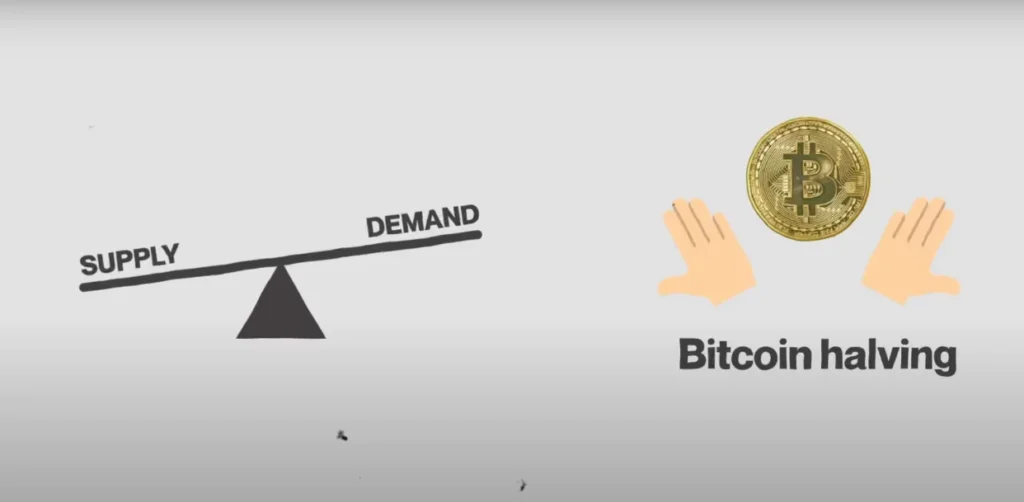
Historical Impact On Bitcoin’s Price Post-halving
The phenomenon of Bitcoin halving has consistently piqued the interest of cryptocurrency enthusiasts and investors alike. In essence, Bitcoin halving refers to the event where the reward for mining new blocks is halved, meaning miners receive 50% less BTC for verifying transactions.
This event occurs approximately every four years, and historically, it has had an intriguing impact on Bitcoin’s market price.
Factors Influencing Post-halving Price Movements
Understanding what can drive the price of Bitcoin after a halving event is crucial. Here’s a brief rundown of contributing factors:
- Supply and Demand: As the rate at which new bitcoins enter circulation slows down, a decrease in supply, with sustained or increased demand, can lead to a price increase.
- Miner Economics: Reduced block rewards impact miners’ profits, potentially leading to decreased selling pressure if miners decide to hold onto more of their newly mined coins in anticipation of higher prices.
- Market Psychology: The anticipation and narrative surrounding halving events can stimulate interest and investment in Bitcoin, pushing prices upward.
Perspectives On The Next Halving
While past performance can offer some insights, cryptocurrency markets are notoriously volatile and unpredictable. Here’s what to consider for the next Bitcoin halving:
- Previous Trends: If history repeats itself, we might expect an upswing following the halving. Though, this uptrend is not guaranteed and can be influenced by broader market conditions at the time of the event.
- Long-term Views: Some analysts advocate for a long-term perspective, suggesting that the impacts of halving on BTC may unfold over months or even years following the event.
No Crystal Ball For Bitcoin’s Future
Predicting the exact outcomes post-halving is akin to gazing into a crystal ball. As you weigh the evidence and opinions:
- Speculative Nature: Keep in mind that Bitcoin and crypto at large are speculative markets, subject to dramatic shifts based on investor sentiment and external factors.
- Diverse Opinions: Experts offer a myriad of predictions – some bullish, some bearish. It’s vital to consume such forecasts with caution and perform your own thorough analysis.
In the dance of supply and demand, halving is a significant step, but it’s far from the only one that determines Bitcoin’s value. As the halving curtain rises, all eyes are on this financial stage to see whether Bitcoin will follow its historical script or chart a new, unexpected course.
Frequently Asked Questions For Bitcoin Halving
What Date Is The Next Bitcoin Halving?
The next Bitcoin halving is expected to occur in May 2024. This event typically happens every four years, reducing new Bitcoin issuance by half.
What Happens When Bitcoin Is Halving?
During a Bitcoin halving event, the reward for mining new blocks is cut in half. This reduces the rate at which new bitcoins are created and enters the market, aiming to limit inflation.
How Many Bitcoin Halvings Are Left?
As of the current block reward era, approximately 29 Bitcoin halvings remain before the maximum supply cap of 21 million is reached.
How Long Until Halving Bitcoin?
The next Bitcoin halving is projected to occur in 2024, with the exact date depending on block production speed. As of now, it’s roughly expected in May 2024.
Conclusion
Understanding Bitcoin halving is crucial for both seasoned investors and crypto novices. This event shapes the market, influencing Bitcoin’s scarcity and value. As we anticipate the next halving, staying informed will help in making savvy investment decisions. Embrace the cycle; it’s a fundamental part of Bitcoin’s DNA.

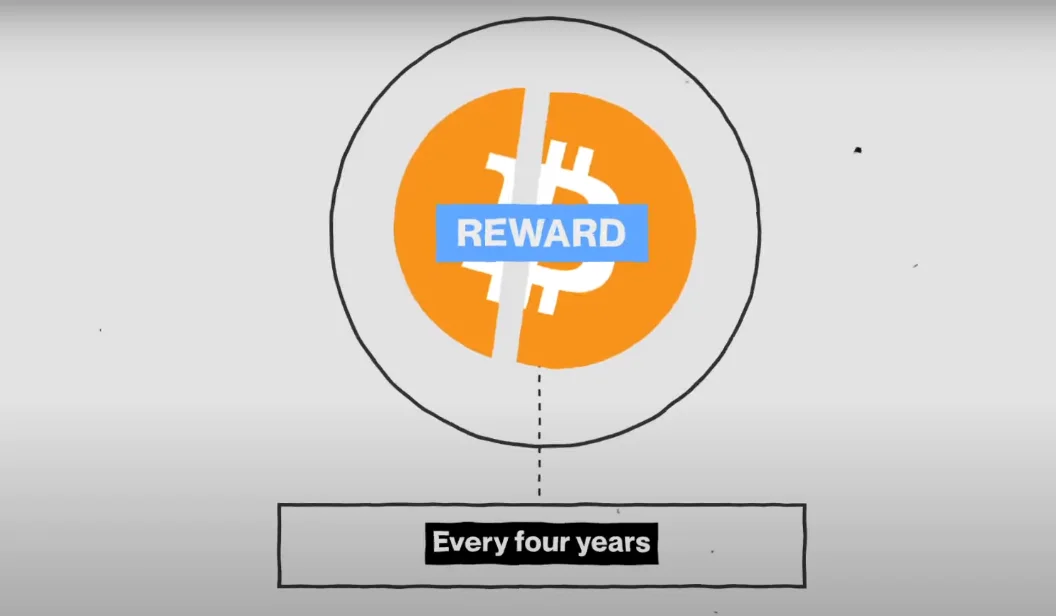
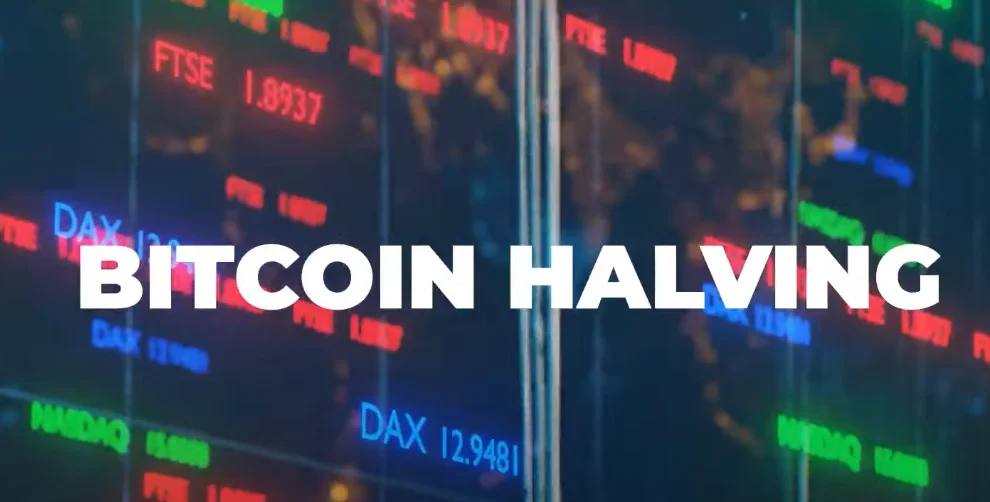
1 thought on “Bitcoin Halving Explained: Future of Cryptocurrency!”